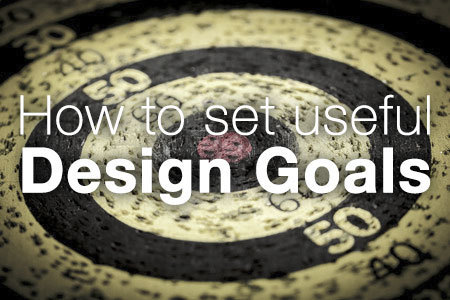Through prototyping and testing the Persuasive Patterns card deck, I’ve held a series of workshops to explore how the cards are best used. The goal was to come up with product ideas making both new and existing products more persuasive – but along the way, I was amazed about the troubles most participants have, defining their own design goals.
As I conducted test after test, I also found the key to successful use of the cards being as much being a good facilitator as it is defining useful goals and conducting useful exercises.

Why are goals important?
Defining good and useful goals to design for is vital to any design task. Without clear design goals, you are designing with no clear direction, purpose, and intent. Good goals help articulate the problem your product tries to solve: the need it satisfies and the value it provides.
The most effective designers are those who end up with a product that reflects their original intent; those who problem-solve within the framework of understood and well-defined problems. Time spent investigating needs, visions, wants, and dreams will dramatically pay off in the final product. It is through the union of design goals and reality that we can create great products.
The most effective designers are those who end up with a product that reflects their original intent
Aligning user goals with the business
A common flaw when choosing the right design goal to design for, is to either focus either too much on user goals or or too much on business goals. Focusing solely on user goals might result in suffering profits. Focusing solely on business goals will most likely result in the same – profits will follow user activity, but most likely will not make users stick around for long.
First define your business goals
Start by defining your business goals; desireable outcomes of your business. Business goals should represent the change you want in your business. What change do you want to achieve? Ask yourself these questions: What are you hoping to accomplish with your website? What are the three most important priorities for your website? What do users have to do, in order for your business to be successful?
Goals are specific strategies to leverage to accomplish your overall business objective. Where your business objectives operate on a higher strategic level like “sell more stuff”, “create happy customers”, and “improve marketing effectiveness”, goals are the next drill down.
Goals represent specific strategies to achieve a business objective. Drilling down to find the goals is about asking questions that start with “how do we…”. These will reveal specific strategies to reach your business objectives. Examples are:
- How do we get users to upload more pictures?
- How do we get more pageviews?
- How do we convert readers to members?
- How do we get users to tell us what they like?
- How do we get users to spend more time with our service?
- How do we get users to comment more?
Keep going exploring new questions until you feel as if you have struck the change that will make your business go in the right direction. For your business to change in the right direction, you will want to influence user behavior. The business goals you want to design for should be mapped to the behavioral goals you want users to do in order to make your business change.
It is common to settle on one goal only to find out that the real goal was an important variety.
Then explore user goals
Continue to look for the “why” of why users are doing what they are doing – until you have found a user goal that is concrete enough for you to be able to satisfy it.
Then, look at what goals your users have. Why did they come to your site in the first place? What problem do they want help with? What job do you help them solve? Look for reasons why users are doing what they are doing: for the essence of their actions. Continue to look for the “why” of why users are doing what they are doing – until you have found a user goal that is concrete enough for you to be able to satisfy it.
To explore user goals, you need to look at the world from the user’s perspective. Get in their shoes and dwell into their needs. Common examples of user goals are:
- I want to get something others don’t have
- I want to feel good about myself
- I want to be good at what I love
- I want to get acknowledged for my work
- I want to find more of the things I like
- I want to receive feedback on my work
Finally, find the sweet spot in the middle
The next step is to combine the two worlds. Business- and user goals need to match for your continued success – so you want to aim for the sweet spot in the middle. You want to find which of your business goals that align with what users want.


